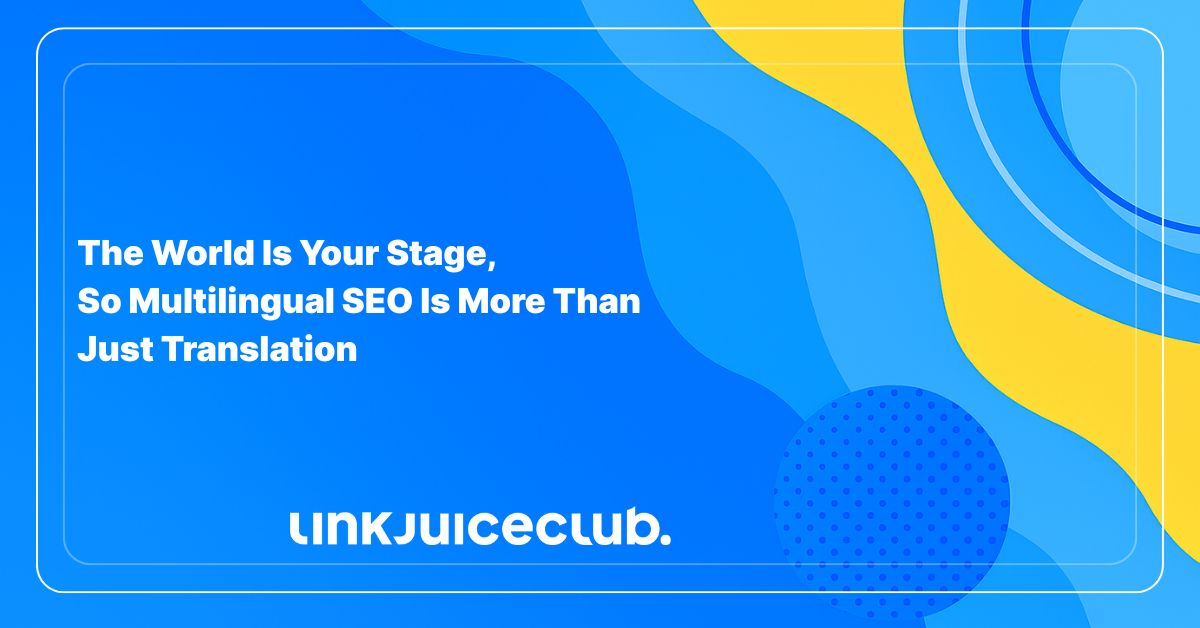
The World Is Your Stage, So Multilingual SEO Is More Than Just Translation
If your website only speaks one language, it’s kind of like running a global business with a No Entry sign in 99% of the world’s storefronts.
Multilingual SEO is your passport to the rest of the planet, an approach that doesn’t just translate your content but reintroduces it to new audiences, cultures, and search behaviors in a way that feels tailor-made.
In a world where people ask Google for everything from best pizza in Naples to köstlicher Käsekuchen in Berlin, sticking to English-only SEO is like whispering in a stadium full of people shouting in different languages. If your goal is growth, reach, and real cultural connection, multilingual SEO is how you stop being the quiet tourist and start becoming a local.
Speaking Their Language (Literally)
Why is multilingual SEO important? Simple: because not everyone searches in English.
Beyond clicks and rankings, it’s about connection. It’s how you show your audience that you’re not just selling to them, you get them.

Whether you’re a global e-commerce brand, a travel site looking to reach new tourists, or just trying to build a wider community, multilingual SEO helps you stop shouting into the void and start having meaningful conversations.
So… What Is Multilingual SEO, Really?
True multilingual strategy is very detailed. You’ve got to nail the cultural tone, rethink your keywords, and avoid sounding like a walking textbook.
It’s about giving every visitor, regardless of location, a tailored experience that feels like your brand just gets them.
Put simply, multilingual SEO is all about tuning your site’s content to show up in searches across different languages. Not just any translation will do. you’ve got to factor in context, tone, and cultural relevance.
Yes, It’s Different from Regular SEO
Standard SEO is like prepping your site for one audience. Multilingual SEO is like prepping for ten, each with different slang, search behavior, and expectations.
You’re dealing with regional expressions, different content angles, and sometimes even different search engines (hello, Baidu). And don’t even get us started on URL structures – subdomains, subfolders, hreflangs, etc.
Multilingual SEO stacks on top of your usual SEO efforts. It’s trickier, yes, but it’s also how you go from local hero to international powerhouse.
Multilingual SEO As A Way To Grow Globally
Do you want to grow globally without booking a single flight? That’s the magic of multilingual SEO. Here’s why multilingual SEO deserves a front-row seat in your strategy.
Your Passport to Global Visibility
Think of multilingual SEO as your digital visa to new markets. Multilingual SEO helps you show up where it matters, right in the middle of local search results, not buried under a pile of foreign content.
Selling eco-friendly sneakers? Calling them baskets écolos in France or zapatillas sostenibles in Argentina isn’t translation; it’s location-aware ranking.
Making Non-English Speakers Feel Right at Home
Ever walked into a restaurant with a menu you couldn’t read? That’s what visiting a monolingual website feels like to most of the world.
When your content, buttons, and product info speak a visitor’s native tongue, they stick around longer. They trust you more. Multilingual SEO helps you offer that warm, familiar experience.
Bounce Less. Engage More.
When people land on your site and actually understand what you’re saying – they stay. They scroll. They explore. That means better engagement and lower bounce rates, two things every SEO strategy dreams about.
Optimized, localized pages show users they’re in the right place. And if you’ve done your job with the titles and meta descriptions in their language, they’ll likely click through instead of scrolling past.
English-only websites are like playing poker with half the deck. Multilingual SEO gives you the full stack.
Building a Global SEO Game Plan
Do you want to go global with your content? Great. A real strategy needs to speak your audience’s language and their mindset! 🌍
Start With Market Intel, Not Guesswork
Before you start translating About Us into Finnish, figure out who actually wants what you’re selling. Peek into your analytics. Where are visitors coming from? Are they bouncing like bored teenagers or sticking around?
Semrush or Google Analytics can give you all the info on which countries you should target. Spot the trends, spy on your competitors, and tailor your content roadmap accordingly.
Keywords: Think Local, Search Global
One-size-fits-all keywords? Big mistake. Just because travel insurance works in English doesn’t mean it cuts it in Italian. Maybe it’s assicurazione viaggio, and maybe people actually search for something completely different.
Skip the lazy auto-translations and work with native speakers or smart tools to dig up local keyword gold. Context matters. So does slang. Aim to sound like a local, not a lost tourist.
Don’t Let Your URLs Get Lost in Translation
Want Google to know which version of your site belongs where? Get your URL structure right.
You’ve got options!
- Subfolders: /de/, /fr/ – clean, tidy, manageable. ✈️
- Subdomains – de.example.com, if you like more separation. ✈️
- Country-code domains – example.fr, example.de—strong local trust, but more maintenance. ✈️
Each setup has pros and cons, but the key is consistency and clarity. Help users (and search engines) land on the right doorstep.
Speak Their Language, Visually and Culturally
Real localization goes beyond words. A landing page for Tokyo shouldn’t feature stock photos of Central Park or jokes only New Yorkers get. It’s about tone, visuals, offers, everything.
Swap out idioms that don’t translate. Choose imagery that makes sense locally. Customize CTAs so they actually resonate. And yes rework your meta tags to match the new flavor.
Tech Talk: Making Multilingual Websites Work
If content is king, technical SEO is the castle walls. Without the right setup, even your best-translated pages might be invisible in search – or worse, confusing to users.
Hreflang: The Multilingual Matchmaker
Search engines aren’t mind readers. That’s where hreflang tags come in. These tiny bits of code act like polite introductions: Hey Google, this page is for folks in Germany who speak German.
Without hreflang, your English page might pop up for someone in Tokyo… awkward. 🥶
Use it correctly, and you steer users to the content made just for them, in their language, with no weird redirects or duplicated nonsense.
Meta Tags That Speak the Right Language
Your meta titles and descriptions shouldn’t just be translated, they should perform. That means reflecting local search behavior, user intent, and tone.
Don’t just recycle the same boring description in 12 languages. If someone in São Paulo searches differently than someone in Madrid, your meta copy should reflect that. It’s small stuff, but it builds trust fast.
Bonus? Properly localized meta tags often lead to higher click-through rates. Because when people feel like you’re speaking their language, they’re more likely to stick around.
Common Multilingual SEO Hiccups (and How to Fix Them)
Taking your content global sounds glamorous, until you run into the fun stuff like misfired translations, duplicate content chaos, or titles that offend an entire culture by accident.
Lost in Translation? Say Less (But Say It Right)
Don’t just translate – localize! That means using phrases and idioms that feel native to your audience. Work with fluent speakers, not just bilingual freelancers. Run real keyword research in each target language, because what ranks in Berlin probably won’t fly in Bogotá.
Culture Shock? Tune Your Strategy to Local Vibes
What works in one country might totally flop in another, and we’re not just talking currency. From humor to holiday references, cultural nuance is everything.
Want higher engagement? Ditch the generic global tone and craft content that resonates. Use localized keyword tools to discover what people actually search for, not just what you think they do.
Treat Every Language and Region as Its Own Opportunity
Multilingual SEO is a mindset shift. It means treating every language and region as its own opportunity. The internet is global. Your SEO strategy should be too!





